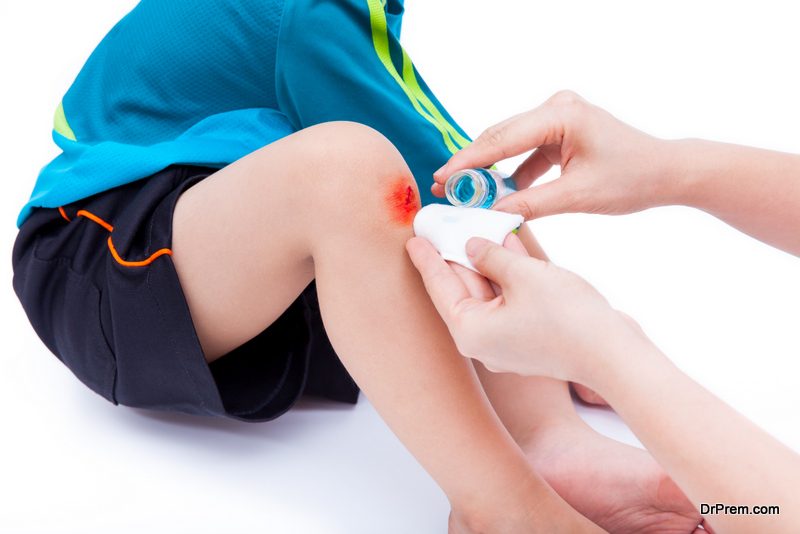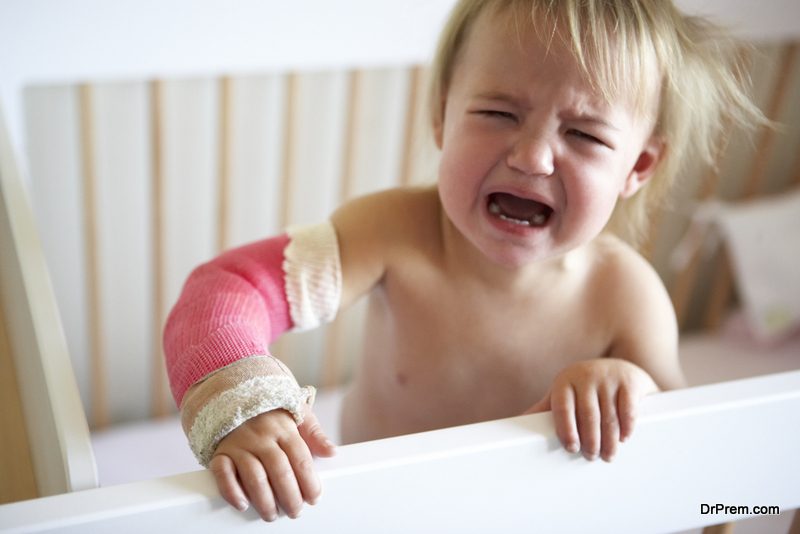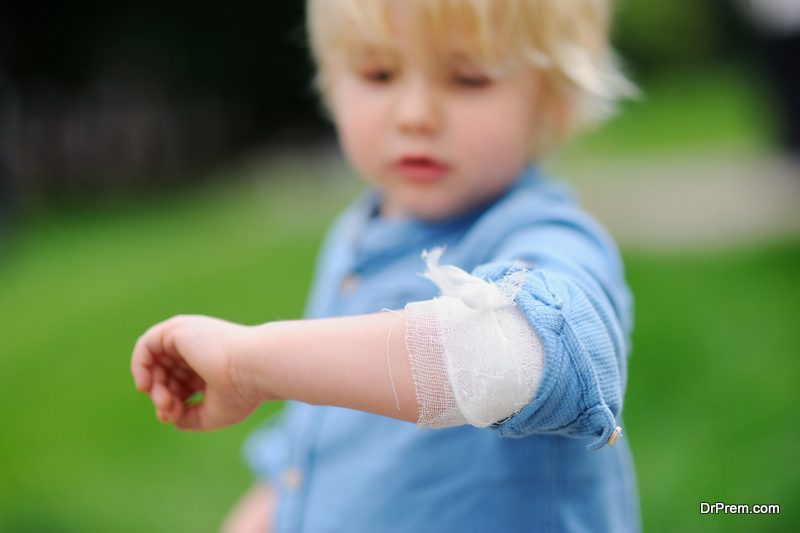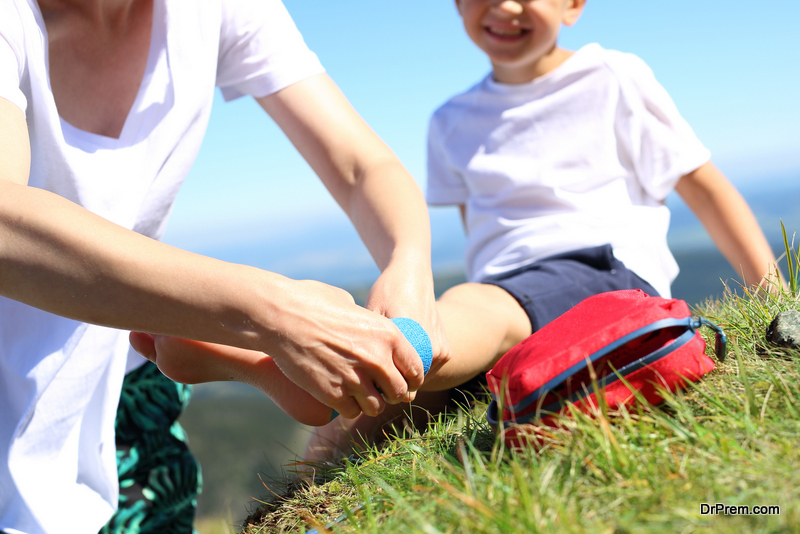When it comes to health and safety, basic principles create a foundation for everyday people to perform potentially lifesaving tasks. As parents, it’s your primary responsibility to ensure the safety of your child. And when there are children around, accidents are bound to happen. Knowing how to act in case of an emergency and keeping calm can mean the difference between a minor incident and a major one. Read on to discover some common first aid issues and how to properly address them.
Bleeding
 Cuts and scrapes are a common occurrence in kids and can happen for a variety of reasons from trips and falls, to handling sharp or unsafe objects. The first step in stopping any type of bleeding is to apply pressure to the wound. Minor bleeding will eventually stop on its own, but if the flow is steady or severe, you need to apply pressure immediately to stop blood loss and prevent shock. Using a clean, dry cloth, apply pressure directly to the wound and don’t remove it until help arrives. This pressure will help the blood form a clot, which the body’s way of naturally stopping bleeding. If possible, lift the injured limb or wound above the person’s heart. This can sometimes reduce the flow of blood, helping stop it more quickly. It’s important to always keep a well-stocked first aid kit on hand for occasions such as this. If you’re not sure what items your first aid kit needs, check it out here!
Cuts and scrapes are a common occurrence in kids and can happen for a variety of reasons from trips and falls, to handling sharp or unsafe objects. The first step in stopping any type of bleeding is to apply pressure to the wound. Minor bleeding will eventually stop on its own, but if the flow is steady or severe, you need to apply pressure immediately to stop blood loss and prevent shock. Using a clean, dry cloth, apply pressure directly to the wound and don’t remove it until help arrives. This pressure will help the blood form a clot, which the body’s way of naturally stopping bleeding. If possible, lift the injured limb or wound above the person’s heart. This can sometimes reduce the flow of blood, helping stop it more quickly. It’s important to always keep a well-stocked first aid kit on hand for occasions such as this. If you’re not sure what items your first aid kit needs, check it out here!
Allergic Reactions and Bee Stings
Allergic reactions can be a very scary thing. That’s because for some people, it results in difficulty breathing, severe swelling or rash, and even anaphylactic shock. For those who have severe food or animal allergies, they often carry an Epipen in case of emergency. An Epipen contains a medication called epinephrine, which helps counteract your body’s allergic reaction to something. It helps relax the airways and may even reverse rapid decreases in a person’s blood pressure. Epipens are administered by placing the orange tip of the pen flush against the person’s thigh, push the injector firmly until you hear it “click”, and hold firmly in place for 3-5 seconds. This is the procedure for severe allergic reactions. Sometimes, an allergic reaction is mild. If a person mentions an itchy or swollen tongue, difficulty breathing, or breaks out in a rash or hives, they may be having an allergic reaction. Take note of what the person recently came into contact with, whether externally or ingested. Medications like Benadryl and other diphenhydramine help treat symptoms caused by an allergic reaction. If the child has been stung by a bee, remove the stinger and apply ice to help reduce swelling. Check for signs of an allergic reaction. If none are present, the child will be fine in a few minutes once the initial pain and shock of being stung subsides.
Broken or Fractured Bones
 Without an X-ray machine, you can’t tell if your child has broken, sprained, or fractured a body part. Broken and fractured bones are common in children as their bones are still developing and are sometimes weak, leaving them vulnerable. The good news is, because a child’s bones are constantly growing, they repair and mend very quickly. Sometimes, in half the time it takes for an adult with the same injury. If you suspect your child has broken or fractured a bone, it’s important to stabilize the body part to limit movement and prevent them from worsening the injury. This can be done using a splint or sling. You may need to craft one of these yourself. A sling is relatively easy and can be made using a towel, small blanket, or piece of clothing. A splint requires several materials including a flat board or other stabilizer, padding, and ropes, strings, or clothing to secure the splint in place. By putting the injured person’s limb on the board, padding it, and securing it in place with ropes or straps, you’re helping stabilize the injury and preventing further movement or damage. Splints are for temporary treatment. If you believe your child has a break or fracture, visit your local doctor’s office or other facility where X-rays are performed.
Without an X-ray machine, you can’t tell if your child has broken, sprained, or fractured a body part. Broken and fractured bones are common in children as their bones are still developing and are sometimes weak, leaving them vulnerable. The good news is, because a child’s bones are constantly growing, they repair and mend very quickly. Sometimes, in half the time it takes for an adult with the same injury. If you suspect your child has broken or fractured a bone, it’s important to stabilize the body part to limit movement and prevent them from worsening the injury. This can be done using a splint or sling. You may need to craft one of these yourself. A sling is relatively easy and can be made using a towel, small blanket, or piece of clothing. A splint requires several materials including a flat board or other stabilizer, padding, and ropes, strings, or clothing to secure the splint in place. By putting the injured person’s limb on the board, padding it, and securing it in place with ropes or straps, you’re helping stabilize the injury and preventing further movement or damage. Splints are for temporary treatment. If you believe your child has a break or fracture, visit your local doctor’s office or other facility where X-rays are performed.
CPR
Everyone should have basic CPR training. Although it’s an extremely scary undertaking and one that some people shy away from, CPR (cardiopulmonary resuscitation) can ultimately save a person’s life and prevent life changing brain damage. When someone enters cardiac arrest, their heart is no longer beating. Without immediate attention, that person will die. The best way to learn proper CPR technique is by taking a CPR/First Aid course. This certification generally lasts for 2 years and is offered at many hospitals and medical facilities for a small fee. Many locations across the country also have AEDs, or automated external defibrillator, which are electronic devices used to monitor the heart’s rhythm and send a shock to the heart to restore normal rhythm. If someone enters cardiac arrests, call 911 immediately and begin chest compressions. Even if you’re not versed or trained in CPR, compress hard on the patient’s chest, allowing it to rise between compressions. This will help restart the heart beating, blood flow and oxygen to the brain. If you are trained, perform rescue breathing as well. It’s important to take immediate action in this type of situation, regardless of your nerves or apprehension.
Minor Burns
 Sadly, burns are another common injury among children due to their curious nature. If your child accidentally burns themselves on a hot stove, iron, or are burned by boiling water or another hot substance, you should take immediate action. First, stop the burn. This means cleaning off any substances on the surface of the skin that may be causing the burn or turning off the heat source and moving the child away. For mild burns, run cool water over the affected area. Don’t use ice or any ointments or creams, which may seal the burn into the skin. Instead, wrap the area in dry, non-sticking gauze. Make the child comfortable using ibuprofen or an acetaminophen for pain. More serious, deeper burns require immediate medical attention. Take the above mentioned steps to help ease the patient’s discomfort but consult a medical profession for further assessment and care.
Sadly, burns are another common injury among children due to their curious nature. If your child accidentally burns themselves on a hot stove, iron, or are burned by boiling water or another hot substance, you should take immediate action. First, stop the burn. This means cleaning off any substances on the surface of the skin that may be causing the burn or turning off the heat source and moving the child away. For mild burns, run cool water over the affected area. Don’t use ice or any ointments or creams, which may seal the burn into the skin. Instead, wrap the area in dry, non-sticking gauze. Make the child comfortable using ibuprofen or an acetaminophen for pain. More serious, deeper burns require immediate medical attention. Take the above mentioned steps to help ease the patient’s discomfort but consult a medical profession for further assessment and care.
In most situations, the first few moments of an accident or emergency are most crucial. Having basic first aid knowledge can help you quickly assess the situation and react properly, providing lifesaving care to a patient or child.
Article Submitted By Community Writer




